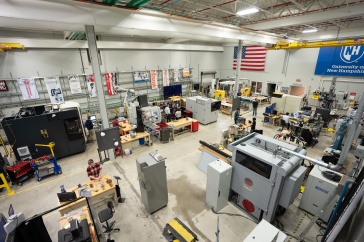
The Van Allen Probes elliptical orbits will range in altitude from 373 to 23,000 miles. Artist's rendering courtesy of Johns Hopkins Applied Physics Laboratory
One year after their launch from Cape Canaveral Air Force Station on Thursday, Aug. 30, 2012, NASA’s twin Van Allen Probes have already fundamentally changed how we understand the Van Allen radiation belts that encircle our planet.
The radiation belts are two donut-shaped regions of highly energetic particles— an inner belt extending 4,000 miles in space, and an outer belt 8,000 to 26,000 miles above Earth. Discovered at the dawn of the space age in 1958 by the probes’ namesake, astrophysicist James A. Van Allen of the University of Iowa, half a century later the belts are showing themselves to be more dynamic and mysterious than initially thought.
Data from the probes, including a rich set derived by a University of New Hampshire-led suite of instruments, are providing dazzling, unexpected discoveries—some made just days after the twin satellites soared into orbit. The mission has answered one long-standing question about the nature and behavior of the belts, and revealed the existence of a third belt between the two known structures. In short, the mission has rewritten the textbook on this harsh region of near-Earth space where “killer electrons” can travel at nearly the speed of light.
With the first year of discovery and enhancements in operations as a cornerstone, the science teams of the Van Allen Probes (formerly named the Radiation Belt Storm Probes) are looking forward to unlocking further mysteries and advancing our knowledge of particle physics and how to better protect space-based technologies like satellites.
“There’s a continued sense of excitement about this mission because the science outcomes are absolutely stunning,” says Harlan Spence, director of the UNH Institute for the Study of Earth, Oceans, and Space and lead scientist for a Van Allen Probe instrument suite at the heart of the recent discoveries.
UNH-led Instrument Suite Front and Center
The Energetic Particle, Composition, and Thermal Plasma Suite (ECT) led by UNH contains the Relativistic Electron Proton Telescope (REPT) instrument that was turned on shortly after the twin spacecraft were deployed. The telescope, which “sees” high-energy particles rather than light, immediately sent back data that at first confounded scientists but then provided a eureka moment: seen for the first time was a transient third radiation belt of high-energy particles formed in the wake of a powerful solar event that happened shortly after REPT began taking data.
"We watched in amazement as the outer radiation belt disappeared rapidly, but not completely; a small sliver of very energetic electrons remained at its inner edge,” notes Spence. "When the main outer electron belt reformed over subsequent days, the sliver remained thus creating the transient, three-belt structure.”
The new belt was destroyed four weeks later by another solar storm – another new observation previously unavailable until the Van Allen Probes mission.
Only days after the transient third belt was seen, on Sept. 5 members of the Electric and Magnetic Field Instrument Suite and Integrated Science (EMFISIS) team, which also includes UNH scientists and engineers, made an audio recording of radio waves in the belts, at a frequency audible to humans, known as “chorus.”
While scientists have known about chorus since the 1950s, these new high-quality recordings became known as “the sounds of space” and drew a great deal of interest around the world. Chorus is caused by plasma waves in the belts, and is thought to be related to the process that accelerates electrons to speeds that can harm spacecraft and astronauts. Lead scientist for EMFISIS is Craig Kletzing of the University of Iowa, Iowa City and a former research associate professor at the UNH Space Science Center.
One fundamental question the mission hopes to answer is how the particles in the belts are being accelerated to nearly relativistic (close to the speed of light) speeds: Is it an external force, or is it happening within the belts themselves? On July 25, researchers published data from an early 2012 event that showed there is definitely an internal particle accelerator.
"We have real evidence that the changes originate from within the belts themselves,” says Geoff Reeves of the Los Alamos National Laboratory in Los Alamos, N.M. and lead scientist on the REPT instrument. In fact, Reeves and other researchers are looking at the chorus waves studied by Kletzing and the EMFISIS team to see if and how chorus (or another type of electromagnetic wave) is behind the acceleration. “The Van Allen Probes are equipped with instruments that should help us figure that out as well,” Reeves says.
Looking Forward to Year Two
For the second year of the Van Allen Probes mission, the teams are eager to expand both their queries and their instruments. “Every instrument has a personality,” Spence says. “Ours are revealing riches we didn’t anticipate, and showing us opportunities beyond what we had baselined. The increase in data download rates, and the knowledge we now have of the ECT instruments, gives us the opportunity to think about how best to use the capabilities and technologies to address new questions in better ways. It’s like designing a better mousetrap on the fly – ‘Let’s see what we can catch!’”
Originally published by:
UNH Today
-
Written By:
Staff writer | Communications and Public Affairs

















































